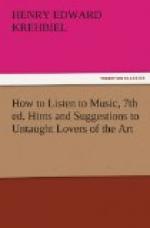[Music illustration]
[Sidenote: The Courante.]
The Courante, or Corrente ("Teach lavoltas high and swift corantos,” says Shakespeare), is a French dance which was extremely popular in the sixteenth, seventeenth, and eighteenth centuries—a polite dance, like the minuet. It was in triple time, and its movement was bright and brisk, a merry energy being imparted to the measure by the prevailing figure, a dotted quarter-note, an eighth, and a quarter in a measure, as illustrated in the following excerpt also from Mersenne:
[Music illustration]
The suite composers varied the movement greatly, however,
and the
Italian Corrente consists chiefly of rapid running
passages.
[Sidenote: The Sarabande.]
The Sarabande was also in triple time, but its movement was slow and stately. In Spain, whence it was derived, it was sung to the accompaniment of castanets, a fact which in itself suffices to indicate that it was originally of a lively character, and took on its solemnity in the hands of the later composers. Handel found the Sarabande a peculiarly admirable vehicle for his inspirations, and one of the finest examples extant figures in the triumphal music of his “Almira,” composed in 1704:
[Sidenote: A Sarabande by Handel.]
[Music illustration]
Seven years after the production of “Almira,” Handel recurred to this beautiful instrumental piece, and out of it constructed the exquisite lament beginning “Lascia ch’io pianga” in his opera “Rinaldo.”
[Sidenote: The Gigue.]
[Sidenote: The Minuet.]
[Sidenote: The Gavotte.]
Great Britain’s contribution to the Suite was the final Gigue, which is our jolly and familiar friend the jig, and in all probability is Keltic in origin. It is, as everybody knows, a rollicking measure in 6-8, 12-8, or 4-4 time, with twelve triplet quavers in a measure, and needs no description. It remained a favorite with composers until far into the eighteenth century. Shakespeare proclaims its exuberant lustiness when he makes Sir Toby Belch protest that had he Sir Andrew’s gifts his “very walk should be a jig.” Of the other dances incorporated into the suite, two are deserving of special mention because of their influence on the music of to-day—the Minuet, which is the parent of the symphonic scherzo, and the Gavotte, whose fascinating movement is frequently heard in latter-day operettas. The Minuet is a French dance, and came from Poitou. Louis XIV. danced it to Lully’s music for the first time at Versailles in 1653, and it soon became the most popular of court and society dances, holding its own down to the beginning of the nineteenth century. It was long called the Queen of Dances, and there is no one who has grieved to see the departure of gallantry and grace from our ball-rooms but will wish to see Her Gracious Majesty restored to her throne. The music of the minuet is in 3-4 time, and of stately movement. The Gavotte is a lively dance-measure in common time, beginning, as a rule, on the third beat. Its origin has been traced to the mountain people of the Dauphine called Gavots—whence its name.




